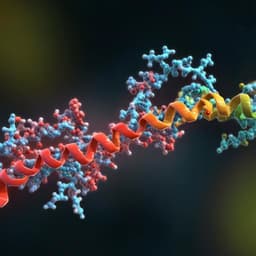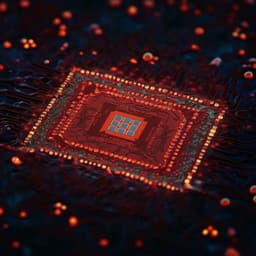
Engineering and Technology
Generative design of stable semiconductor materials using deep learning and density functional theory
E. M. D. Siriwardane, Y. Zhao, et al.
Explore groundbreaking advancements in semiconductor research with work conducted by Edirisuriya M. Dilanga Siriwardane, Yong Zhao, Indika Perera, and Jianjun Hu. This study unveils a novel computational pipeline integrating generative adversarial networks and high-throughput calculations, leading to the discovery of 12 stable AA'MH6 semiconductors boasting remarkable wide-bandgap properties.
~3 min • Beginner • English
Introduction
Semiconductors are essential components in modern electronic, optoelectronic, and energy-conversion devices. Their tunable electrical properties, including variable resistance controlled by light and heat, make them crucial for applications such as LEDs, integrated circuits, photovoltaics, and solar cells. While elemental semiconductors like Si and Ge and their compounds dominate current technologies, diverse semiconductor properties are needed for specialized industrial applications (e.g., SiC for high-temperature and high-power environments due to its thermal conductivity, breakdown strength, and wide bandgap). Computational discovery has become vital for exploring new semiconductors; prior high-throughput screening and data mining have identified candidates for radiation detection, photovoltaics, and light-emitting applications.
Generative adversarial networks (GANs) can learn complex data distributions but have seen limited use in materials generation due to challenges in representing diverse crystal structures and enforcing physical and symmetry constraints. Early works (e.g., CrystalGAN and WGAN-GP on specific systems) focused on limited material families. CubicGAN is the first large-scale GAN framework to generate crystalline materials.
In this work, we develop a binary classifier to filter nonmetals (semiconductors/insulators) from dynamically stable quaternary cubic materials generated by CubicGAN. We analyze elemental and electronic features predictive of nonmetallicity, and we perform DFT calculations to validate thermodynamic stability and semiconductor properties. We identify 12 cubic AA'MH6 semiconductors stable against competing phases and investigate their structural, mechanical, thermodynamic, and electronic properties.
Literature Review
The study situates itself within computational materials discovery, highlighting prior high-throughput DFT screening efforts that identified candidate semiconductors for radiation detection, photovoltaics, solar absorbers, and light-emitting applications. It reviews challenges in applying GANs to crystal generation: heterogeneous stoichiometries, varying unit-cell sizes, and the need to satisfy physics and symmetry constraints. Early GAN-based materials works (e.g., CrystalGAN for hydrides, WGAN-GP for Mg–Mn–O) were limited in scope and scale. CubicGAN is presented as a large-scale approach to generate ternary and quaternary cubic materials, addressing training stability via Wasserstein GAN with gradient penalty and incorporating symmetry-aware constraints and postprocessing to enforce charge neutrality and negative formation energy before DFT validation.
Methodology
Generative pipeline (CubicGAN):
- Targeted generation of ternary and quaternary cubic materials in space groups 221, 225, and 216 using WGAN-GP for training stability. Inputs include random noise, element embeddings (23 elemental properties), and space-group one-hot vectors. To simplify structure representation, fractional coordinates are restricted to the set {0.0, 0.25, 0.5, 0.75}.
- Training data from OQMD; evaluation against Materials Project and ICSD. Postprocessing retains generated structures with readable CIFs, charge neutrality, and negative formation energies (predicted by CGCNN). Focus on materials categorized by prototype (anonymous formula + space group).
- Scale: From 10 million generated materials, most cubic entries in MP/ICSD can be rediscovered; 24 nonexisting ternary and 1 nonexisting quaternary prototypes identified. DFT relaxations successfully completed for 36,847 candidates; 506 are dynamically stable as verified by phonon dispersions.
Nonmetal–metal classifier:
- Dataset: 4,016 cubic quaternary materials from MP, with 2,578 nonzero-bandgap (semiconductors/insulators) and 1,438 metals.
- Features: 55 elemental/electronic attributes (e.g., first ionization energy, atomic volume, electronegativity, total and orbital-resolved valence electron counts). For each compound, compute composition-weighted averages and maximum differences; total 119 features.
- DNN: Two hidden layers (200 and 100 neurons), ReLU activations, 5% dropout, L2 (Ridge) regularization; Adam optimizer (lr=0.001), binary cross-entropy loss; 500 epochs, batch size 1500. Random 98%/2% train/test split with 10-fold cross-validation on the training set.
- Random Forest Classifier (RFC): Hyperparameters via GridSearchCV; optimized values: n_estimators=500, min_samples_split=10, min_samples_leaf=3, max_depth=90. Also used for feature-importance analysis.
DFT calculations:
- VASP with PAW pseudopotentials and GGA-PBE exchange-correlation. Plane-wave cutoff 500 eV; electronic convergence 1e-8 eV; ionic force convergence 1e-2 eV/Å.
- Brillouin-zone integrations with Monkhorst–Pack meshes (e.g., 14×14×14 for BaNaRhH6 with a≈5.5105 Å) for structural relaxations, band structures, DOS, mechanical, and phonon calculations.
- Phonons computed with Phonopy using 2×2×2 supercells to assess dynamical stability.
- Subsequent analyses include elastic constants, bulk/shear/Young’s moduli, Poisson’s ratio, sound velocities, Debye temperatures, Bader charge transfer, band structures, and PDOS.
Key Findings
- Discovery: 12 thermodynamically and dynamically stable AA'MH6 semiconductors in space group F-43m: BaNaRhH6, BaSrZnH6, BaCsAlH6, SrTlIrH6, KNaNiH6, NaYRuH6, CsKSiH6, CaScMnH6, YZnMnH6, NaZrMnH6, AgZrMnH6, and ScZnMnH6.
- Band gaps (hybrid-functional-based statement and tabulated values): Wide-bandgap semiconductors overall. From reported values: BaNaRhH6 3.018 eV (indirect, CBM X, VBM W); BaSrZnH6 1.586 eV (direct X–X); BaCsAlH6 2.938 eV (indirect G–X); SrTlIrH6 1.625 eV (indirect X–W); CsKSiH6 2.165 eV (indirect G–X); KNaNiH6 3.302 eV (direct X–X); NaYRuH6 2.532 eV (indirect X–W); CaScMnH6 1.272 eV (indirect X–K); YZnMnH6 1.600 eV (indirect X–W); NaZrMnH6 1.569 eV (indirect X–K); AgZrMnH6 1.411 eV (indirect X–K); ScZnMnH6 1.673 eV (indirect X–W).
- Direct vs indirect: Only BaSrZnH6 and KNaNiH6 are direct-gap; the other ten are indirect-gap semiconductors.
- Dynamical stability: Positive phonon frequencies across the Brillouin zone for all 12 materials confirm dynamical stability.
- Mechanical properties: Mn-based AA'MH6 and NaYRuH6 show significantly larger bulk modulus (K) and Young’s modulus (Y) than the others, indicating higher stiffness and resistance to compression (e.g., NaZrMnH6 K≈96.9 GPa, Y≈156.9 GPa; ScZnMnH6 K≈104.3 GPa, Y≈156.3 GPa). Poisson’s ratios lie between 0.2 and 0.4; the maximum observed for SrTlIrH6 (μ≈0.397).
- Thermoelastic/thermal: High average sound velocities and Debye temperatures for Mn-containing compounds and NaYRuH6 (e.g., CaScMnH6 θD≈825.9 K; NaZrMnH6 θD≈813.8 K; NaYRuH6 θD≈633.5 K), suggesting robust lattice stiffness. Specific heats at 300 K range around 106–128 J K−1 mol−1.
- Charge transfer: Bader analysis shows H carries negative charge, with cations at A/A' donating charge; M-site charge varies with chemistry (e.g., strongly positive for Al/Si cases, modest for Mn/Ru/Ni/Ir cases).
- Electronic structure: PDOS indicates d-orbitals of the transition-metal at the M site dominate near the valence-band edge; d-states of transition metals at A/A′ sites contribute less near the Fermi level.
- Application potential: The variability of CBM/VBM k-points suggests tunability of electronic/thermoelectric properties; AA'MH6 compounds are proposed for thermoelectric investigations.
Discussion
The study demonstrates that combining a generative model (CubicGAN), a supervised nonmetal–metal classifier, and high-throughput DFT enables efficient discovery of stable semiconductors, addressing the need for diverse semiconductor materials with tailored properties. The identification of 12 stable AA'MH6 compounds in F-43m validates the pipeline’s ability to produce dynamically stable, thermodynamically viable materials beyond rediscovery of known prototypes.
Electronic-structure results confirm semiconducting behavior with predominantly wide band gaps. The presence of two direct-gap materials (BaSrZnH6 and KNaNiH6) is noteworthy for optoelectronic applications, while indirect-gap compounds remain relevant for power electronics and thermoelectrics. Differences among Mn-containing AA'MH6 and NaYRuH6—specifically their higher bulk and Young’s moduli, higher sound velocities, and elevated Debye temperatures—indicate stiffer lattices and stronger bonding, consistent with their elastic constants. PDOS analysis showing M-site d-orbital dominance near the valence-band edge provides insight into bonding and carrier effective masses, and suggests possible avenues for band engineering via substitution at the M site.
Phonon dispersions exhibit no imaginary modes, substantiating dynamical stability. The spread of CBM/VBM locations across high-symmetry points (X, W, K, Γ) implies that electronic transport and thermoelectric properties could be tuned through composition and strain. Overall, the findings address the research goal by discovering and characterizing new, stable semiconductors with promising mechanical and thermal properties.
Conclusion
This work introduces an end-to-end computational workflow for semiconductor discovery that integrates CubicGAN-based materials generation, a nonmetal–metal classifier leveraging elemental/electronic descriptors, and rigorous DFT validation. Applying this pipeline, the authors discovered 12 dynamically and thermodynamically stable AA'MH6 semiconductors in the F-43m space group. These materials are predominantly wide bandgap semiconductors, with BaSrZnH6 and KNaNiH6 exhibiting direct gaps. Mn-containing AA'MH6 and NaYRuH6 display notably higher stiffness and Debye temperatures, and PDOS analyses highlight the key role of M-site d-orbitals near the band edges. The materials’ tunable band extrema and robust lattice properties suggest potential for thermoelectric and other semiconductor applications.
Future directions include extending generative modeling beyond cubic systems and discrete coordinate sets, incorporating broader space groups and more flexible structural representations, integrating more accurate energetics during generation (e.g., physics-informed or ML-DFT surrogates), exploring dopants/strain for band engineering, and experimental synthesis/validation of the predicted compounds.
Limitations
- Generative scope is restricted to cubic space groups (221, 225, 216) and to a discrete set of fractional coordinates, which limits exploration of broader structural chemistries.
- Postprocessing relies on charge neutrality and ML-predicted negative formation energies prior to DFT, which may filter out some viable candidates and is dependent on surrogate model accuracy (CGCNN).
- While PBE-level DFT settings are detailed for relaxations and phonons, hybrid-functional band-gap computations are referenced qualitatively without methodological details in the provided text.
- Experimental synthesis and validation are not reported; mechanical and thermal properties are purely computational.
- Classifier training and evaluation are confined to cubic quaternary materials from MP; generalization to other chemistries and crystal systems is untested here.
Related Publications
Explore these studies to deepen your understanding of the subject.







